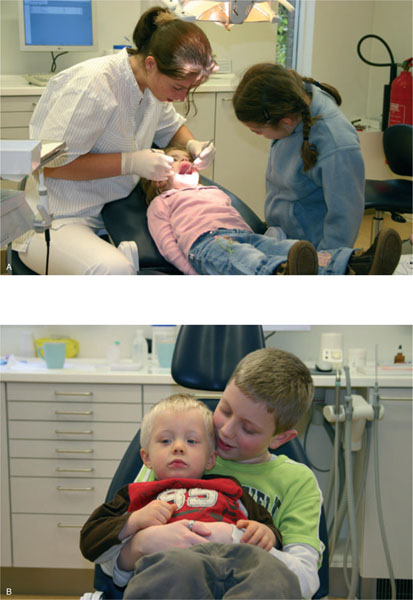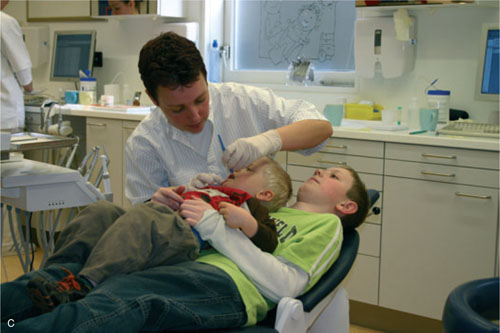8
Local anaesthesia for children
Needless to say, children tend to dread local anaesthesia. The dentist may deal with this in various ways. He/she must win the trust of the child, speak in a manner the child understands, use an injection technique that is effective and does not cause the child any pain, and know and prevent complications. Finally, the dentist must treat the child with empathy.
8.1 Introduction
Dental treatment may sometimes be unpleasant for children. They may find it threatening, they may be afraid of possible pain, and the specific dental sounds and smells may arouse feelings of discomfort. As a consequence, some children are already afraid of the dentist at a very young age. A good relationship of trust between child and dentist as well as painless treatment are essential for child-friendly and adequate dental care.
The dental team must be aware of factors that the child may experience as uncomfortable, and that may be stored in the child’s memory. The manner in which children experience events, the way parents view the treatment of their child, and also the way in which the dentist and dental assistant deal with the child’s behaviour are important factors contributing to a child’s positive memory of dental treatment.
If children go to the dentist regularly, their fear will, in most cases, not increase. Regular visits to the dentist can help to prevent an aggravating treatment having long-term effects. Psychological research has shown that some children are more sensitive than others to what happens to them and are therefore more vulnerable to various interventional situations. They develop fear of the dentist faster than other children. Therefore, vulnerable children must always be treated painlessly and in the same way. This requires a very consistent method of treatment, so that children always know in advance what to expect. In order to prevent painful treatment, it is advisable to anaesthetise children. Moreover, an anaesthetic can prevent undesirable behaviour during the treatment from escalating unnecessarily.
8.2 Experience of pain and fear in children
Not all children react in the same way to (supposed) pain impulses, and pain thresholds seem to vary greatly between children. A toddler may fall down the stairs and, though bruised, may be quickly comforted by the mother or father with a kiss where it hurts. The same toddler may cry inconsolably while fissures on a tooth are being sealed, because the child may expect it to hurt (Box 8.1).
During a child’s life, he or she may be afraid of a series of events. Most fears subside, because the child learns to understand the situation and learns to cope with it. Coping with fears differs from child to child and coping mechanisms change with age. The most universal coping mechanism is to avoid a scary situation. Unfortunately, avoidance behaviour is also a coping style that fully confirms the fear (Box 8.2).
Young children can find support in fearful situations from a parent’s hug. However, they may also express their fear by crying a lot or by trying to run away. As children grow older, they are better able to deal with scary situations. They may fantasise and/or resist verbally. The older they get, the more they understand, so that situations that first made them afraid appear far less scary. In more uncomfortable cases, older children may choose from several strategies, for example discussion or negotiation. However, they also have the choice of direct actions, such as learning to relax if they have a fear of needles or knowing what they can do or think about in order to calm down.
A remarkable aspect of coping in young children is that they do not regard themselves as afraid. One should not be surprised if a young child, who has been crying a lot during dental treatment, afterwards tells his mother quite contentedly that it went well, it did not hurt and he had not cried(!). The crying during the dental treatment was a coping mechanism for keeping control in an uncomfortable situation, and much less a sign that the dentist was doing anything wrong.
When children get older, they can distinguish very well between fear and coping. It is harder to tell from their behaviour, but when asked they can express clearly what they are afraid of and how they deal with it. They know exactly in which situations they need support, when they just need to concentrate and what they fear so much they are unable to deal with.
8.2.1 Security and support
Young children look for security in new or alien situations (Figure 8.1). If they are restless, tense or nervous, the presence of a familiar person will calm them and give support. If parents or carers have had a mixture of positive and negative experiences, they often have a more balanced attitude. The more negative cases parents have experienced, the more they will be on alert and the sooner they want to warn and protect their child. This is the general case and is also the case for the dentist, especially when using anaesthesia.
Figure 8.1 A, B and C Security and support.


If the parent him/herself is scared, the child’s reaction will be the signal to express very negative emotions that the parent has from his/her own dental history. The parent may rush to the child to protect him or her, saying reassuringly, “The dentist isn’t scary at all” or “The injection really won’t hurt”. With this, parents will bring out an aspect that only evokes more fear in the child. Essentially, what they are saying is: “Watch out, there is danger!” and strengthen that signal with attention: “Come now, you’re safe with me”.
Parents can be a support to the child during dental treatment (Box 8.3). However, if a scared parent accompanies the child, this may mean that the child chooses a coping strategy that does not work with the dental treatment being performed. In order to deal with this situation effectively, the dentist must explain this phenom/>
Stay updated, free dental videos. Join our Telegram channel

VIDEdental - Online dental courses


